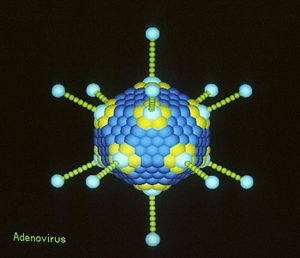Adenoviridae: Difference between revisions
imported>Idan Levi No edit summary |
imported>Idan Levi No edit summary |
||
| Line 11: | Line 11: | ||
===Species=== | ===Species=== | ||
[[Image:Adenoviridae.jpg|500px]] | |||
''Human adenovirus C'' | |||
==Description and significance== | ==Description and significance== | ||
Revision as of 23:35, 31 March 2008
Articles that lack this notice, including many Eduzendium ones, welcome your collaboration! |
Classification
Higher order taxa
Family: Adenoviridae Genus: Mastadenovirus; Aviadenovirus; Atadenovirus; Siadenovirus
Species
Description and significance
Adenoviruses have the ability to infect various animals, including humans, canines and birds. More than 50 different serotypes which are
Describe the appearance, habitat, etc. of the organism, and why it is important enough to have its genome sequenced. Describe how and where it was isolated. Include a picture or two (with sources) if you can find them.
Genome structure
The genome of adenoviridae consists of around 30-38 Kbp. It is linear and is made up of double stranded DNA, with no segmentation. The terminal end of the genome consists of a 55 kDa protein on every 5' end of it. The importance of this is that it enables sufficient replication of that part of the DNA. Furthermore, it is used as primers.
Cell structure and metabolism
The structure of an adenovirus is usually 90-100 nm in diameter. They are nonenveloped and icosahedral (contain 20 faces). The whole virus is made up of a core, which is where the dsDNA is found, fibers external to the capsid, a capsid, and proteins. The lenght of the fibers are around 9-77.5 nm and some contain glycoproteins. The surface of the capsid is made up of 252 capsomers. Twelve of the capsomers pentons and the other 240 are hexons. The core itself is made up of a nucleoprotein complex.
Ecology
Describe any interactions with other organisms (included eukaryotes), contributions to the environment, effect on environment, etc.
Pathology
Adenoviruses have two phases which allow it to cause disease. First - in the early phase - the virus attaches to the host cell using its fibers. This causes the host cell to take in the adenovirus through endocytosis. As the virus makes its way to the nucleus, the virus dissasembles to allow the DNA to be released. Transcription on the viral DNA begins when it is in the nucleus. Initially, the proteins that are produced are used to regulate the translation and transcription of the viral genome. They activate different genes of the virus. Moreover, the allow the virus to survive the immune system of the host. The late phase is started as assembly proteins are made. Genes are made to assemble new viruses. At the same time, translation of the hosts mRNA is stopped by blocking the movement of host mRNA - while the mRNA of the virus is allowed to freely move across the nucleus and into the cytoplasm to be translated. As more and more viruses are made, the host cell dies and releases them.
Application to Biotechnology
Does this organism produce any useful compounds or enzymes? What are they and how are they used?
Current Research
Enter summaries of the most recent research here--at least three required

